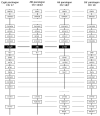Phylogenetic diversification of the globin gene superfamily in chordates
- PMID: 21557448
- PMCID: PMC4399706
- DOI: 10.1002/iub.482
Phylogenetic diversification of the globin gene superfamily in chordates
Abstract
Phylogenetic reconstructions provide a means of inferring the branching relationships among members of multigene families that have diversified via successive rounds of gene duplication and divergence. Such reconstructions can illuminate the pathways by which particular expression patterns and protein functions evolved. For example, phylogenetic analyses can reveal cases in which similar expression patterns or functional properties evolved independently in different lineages, either through convergence, parallelism, or evolutionary reversals. The purpose of this article is to provide a robust phylogenetic framework for interpreting experimental data and for generating hypotheses about the functional evolution of globin proteins in chordate animals. To do this, we present a consensus phylogeny of the chordate globin gene superfamily. We document the relative roles of gene duplication and whole-genome duplication in fueling the functional diversification of vertebrate globins, and we unravel patterns of shared ancestry among globin genes from representatives of the three chordate subphyla (Craniata, Urochordata, and Cephalochordata). Our results demonstrate the value of integrating phylogenetic analyses with genomic analyses of conserved synteny to infer the duplicative origins and evolutionary histories of globin genes. We also discuss a number of case studies that illustrate the importance of phylogenetic information when making inferences about the evolution of globin gene expression and protein function. Finally, we discuss why the globin gene superfamily presents special challenges for phylogenetic analysis, and we describe methodological approaches that can be used to meet those challenges.
Copyright © 2011 International Union of Biochemistry and Molecular Biology, Inc.
Figures




References
-
- Burmester T, Weich B, Reinhardt S, Hankeln T. A vertebrate globin expressed in the brain. Nature. 2000;407:520–523. - PubMed
-
- Burmester T, Ebner B, Weich B, Hankeln T. Cytoglobin: a novel globin type ubiquitously expressed in vertebrate tissues. Mol. Biol. Evol. 2002;19:416–421. - PubMed
-
- Trent JT, Hargrove MS. A ubiquitously expressed human hexacoordinate hemoglobin. J. Biol. Chem. 2002;277:19538–19545. - PubMed
-
- Fago A, Hundahl C, Malte H, Weber RE. Functional properties of neuroglobin and cytoglobin. Insights into the ancestral physiological roles of globins. IUBMB Life. 2004;56:689–696. - PubMed
Publication types
MeSH terms
Substances
Grants and funding
LinkOut - more resources
Full Text Sources

